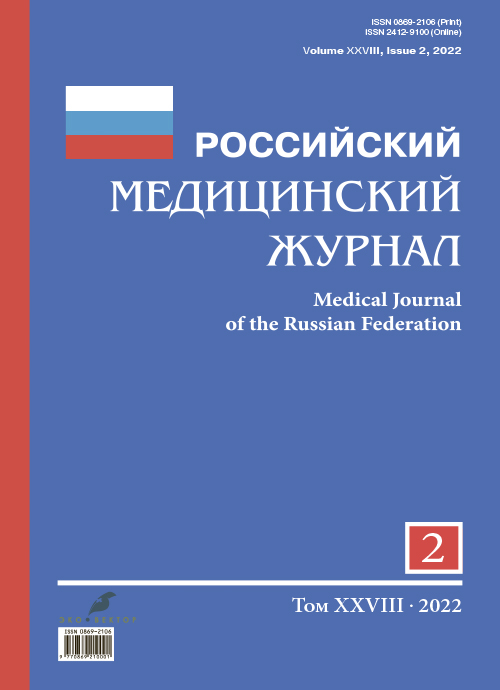Comparative study of the clinical outcomes of immediate sequential bilateral cataract surgery and delayed sequential bilateral cataract surgery
- 作者: Medvedev I.B.1, Pokrovsky D.F.1
-
隶属关系:
- Pirogov Russian National Research Medical University
- 期: 卷 28, 编号 2 (2022)
- 页面: 119-126
- 栏目: Original Research Articles
- ##submission.dateSubmitted##: 20.07.2022
- ##submission.dateAccepted##: 20.07.2022
- ##submission.datePublished##: 15.08.2022
- URL: https://medjrf.com/0869-2106/article/view/109420
- DOI: https://doi.org/10.17816/medjrf109420
- ID: 109420
如何引用文章
详细
BACKGROUND: In the last decade, the number of randomized controlled trials indicating the safety and efficacy of immediate sequential bilateral cataract surgery (ISBCS) comparable to the results of delayed sequential bilateral cataract surgery (DSBCS) has been increasing. However, these studies are practically absent in the practice of domestic ophthalmology.
AIM: To comparatively assess the clinical results of ISBCS and DSBCS.
METHODS: Our observation revealed that 1000 patients (2000 eyes) with binocular cataracts aged 37–68 years (mean age: 56.9±1.3 years), including 82% of males and 18% of females. Patients were divided into two groups: the main group (500 patients, 1000 eyes), who underwent ISBCS according to the developed modified algorithm (ma ISBCS), and the control group (500 patients, 1000 eyes), who underwent DSBCS technology with a break after the first surgical intervention 7–10 days. The study was conducted from January 2017 to September 2021. All patients were operated on by one surgeon. The following monofocal intraocular lenses (IOLs) were implanted to correct aphakia: Acrysof Natural IQ (Alcon, USA), Akreos AO (Bausch & Lomb, USA), and Biflex (Medicontur, Hungary). Biometrics and IOL calculation were performed using an optical biometer IOL Master (Zeiss, Germany). The following clinical efficacy criteria were assessed (before and 3 months postoperatively): the presence of intra- and postoperative complications, measurement of the maximum correctable distance visual acuity (BCVA), and deviation from the target (±0.5 D) refraction.
RESULTS: maISBCS provides almost identical (with DSBCS) clinical results of surgical intervention, which is confirmed by the minimum (0.1%–0.6%, n=1000) level of postoperative complications (in the absence of endophthalmitis), the average values of BCVA (0.94±0.02; 0.95±0.02, p=0.724) and «target» refraction (0.30±0.05; 0.28±0.04, p=0.723), achieving BCVA of 1.0 rel unit (87%–88% of cases), and emmetropic refraction (28%–29% of cases).
CONCLUSION: maISBCS is a promising direction in cataract surgery, especially considering the established (compared to DSBCS) advantages associated with higher efficiency in terms of anisometropia development and the priority of performing in a difficult epidemiological environment, as well as a significant reduction in the financial costs of surgery.
全文:
作者简介
Igor Medvedev
Pirogov Russian National Research Medical University
Email: glazmed@list.ru
ORCID iD: 0000-0001-9155-8736
SPIN 代码: 5779-2406
MD, Dr. Sci. (Med.), Professor
俄罗斯联邦, 1, Ostrovityanova street, 117997, MoscowDmitry Pokrovsky
Pirogov Russian National Research Medical University
编辑信件的主要联系方式.
Email: dfpokrovskiy@gmail.com
ORCID iD: 0000-0002-5475-0398
SPIN 代码: 6487-5793
MD, Cand. Sci. (Med.), Assistant Professor
俄罗斯联邦, 1, Ostrovityanova street, 117997, Moscow参考
- Grzybowski A, Wasinska-Borowiec W, Claoué C. Pros and cons of immediately sequential bilateral cataract surgery (ISBCS). Saudi J Ophthalmol. 2016;30:244–249. doi: 10.1016/j.sjopt.2016.09.001
- Pandey SK, Sharma V. Commentary: Immediate sequential bilateral cataract surgery during the COVID-19 pandemic. Indian J Ophthalmol. 2021;69(6):1585–1586. doi: 10.4103/ijo.IJO_1093_21
- Rush SW, Gerald AE, Smith JC, et al. Prospective analysis of outcomes and economic factors of same-day bilateral cataract surgery in the United States. J Cataract Refract Surg. 2015;41(4):732–739. doi: 10.1016/j.jcrs.2014.07.034
- Amsden LB, Shorstein NH, Fevrier H, et al. Immediate sequential bilateral cataract surgery: surgeon preferences and concerns. Can J Ophthalmol. 2018;53(4):337–341. doi: 10.1016/j.jcjo.2017.10.034
- Richter-Mueksch S, Sacu S, Weingessel B, et al. The influence of cortical, nuclear, subcortical posterior, and mixed cataract on the results of microperimetry. Eye (Lond). 2011;25(10):1317–1321. doi: 10.1038/eye.2011.156
- Arshinoff SA, Bastianelli PA. Incidence of postoperative endophthalmitis after immediate sequential bilateral cataract surgery. J Cataract Refract Surg. 2011;37(12):2105–2114. doi: 10.1016/j.jcrs.2011.06.036
- Serrano-Aguilar P, Ramallo-Fariña Y, Cabrera-Hernández JM, et al. Immediately sequential versus delayed sequential bilateral cataract surgery: safety and effectiveness. J Cataract Refract Surg. 2012;38:1734–1742. doi: 10.1016/j.jcrs.2012.05.024
- Herrinton LJ, Liu L, Alexeeff S, et al. Immediate Sequential vs. Delayed Sequential Bilateral Cataract Surgery: Retrospective Comparison of Postoperative Visual Outcomes. Ophthalmology. 2017;124(8):1126–1135. doi: 10.1016/j.ophtha.2017.03.034
- Pokrovsky DF, Ovechkin NI. Visual acuity and quality of life in heavy visual workload patients with bilateral cataract before and after phacoemulsification. Ophthalmology Journal. 2021;14(4):7–12. (In Russ). doi: 10.17816/OV79105
- Tognetto D, Brézin AP, Cummings AB, et al Rethinking Elective Cataract Surgery Diagnostics, Assessments, and Tools after the COVID-19 Pandemic Experience and Beyond: Insights from the EUROCOVCAT Group. Diagnostics (Basel). 2020;10(12):1035. doi: 10.3390/diagnostics10121035
- Neel ST. A cost-minimization analysis comparing immediate sequential cataract surgery and delayed sequential cataract surgery from the payer, patient, and societal perspectives in the United States. JAMA Ophthalmol. 2014;132:1282–1288. doi: 10.1001/jamaophthalmol.2014.2074
- O’Brien JJ. Gonder J, Botz C, et al Immediately sequential bilateral cataract surgery versus delayed sequential bilateral cataract surgery: potential hospital cost savings. Can J Ophthalmol. 2010;45(6):596–601. doi: 10.3129/i10-094
补充文件






